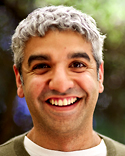Technology Review magazine names three Berkeley scientists to elite group of young innovators
| 18 August 2009
BERKELEY — Three researchers at the University of California, Berkeley, are among an elite group of young scientists to watch, according to the national magazine Technology Review's just-released 2009 list of Top Young Innovators Under 35.
Ali Javey and Dawn Song, both from the Department of Electrical Engineering and Computer Sciences, and Cyrus Wadia of the Haas School of Business and the Lawrence Berkeley National Laboratory (LBNL), were among 35 researchers selected worldwide as top innovators under the age of 35.
They were chosen from more than 300 nominees in research fields spanning medicine, computing, communications, nanotechnology and more.
Below are descriptions of the UC Berkeley innovators and their research:
 Ali
Javey
Ali
Javey Ali Javey, 29, assistant professor in the Department of Electrical Engineering and Computer Sciences and co-director of the Berkeley Sensor & Actuator Center (BSAC), is being honored for his work "painting" nanowires into electronic circuits. Javey combines electrical engineering, materials science, chemistry and physics to engineer nanomaterials for technological applications, including cheap solar cells and high-resolution displays.
One of the most recent developments in Javey's lab is a roller printer tool that uses a glass cylinder to deposit nanowires onto a flexible piece of plastic or silicon wafer in straight and ordered rows. The technique has been used to print transistors and arrays of light-sensing cadmium selenide nanowires, which can be used as photosensors for imaging applications.
 Dawn
Song
Dawn
Song Dawn Song, 34, associate professor in the Department of Electrical Engineering and Computer Sciences, is being recognized for her work on defeating malicious software, or malware, through automated software analysis. Rather than fighting off individual viruses, worms and other malware as they appear, Song's approach is to automate the defense system by developing filters that detect known patterns in malicious code and stopping the code in its tracks.
An example of this approach is the BitBlaze platform Song and her lab have developed. BitBlaze works by analyzing the binary patterns of malicious code and automatically generating a filter against it until a security patch is released, a task that was previously done manually.
The magazine noted that technology spun out of Song's research has already been incorporated into Google's Chrome browser, and she has collaborated with security software companies such as Symantec.
 Cyrus
Wadia
Cyrus
Wadia Cyrus Wadia, 34, co-director of the Cleantech-to-Market program in UC Berkeley's Haas School of Business and a visiting scholar at Lawrence Berkeley National Laboratory), is recognized for his work in developing solar cell technology on a scale that could cost effectively meet global electricity demand.
Wadia has sought out alternative materials to the expensive silicon now used in most photovoltaics. His economic analysis of materials with good electrical properties and the capacity to absorb sunlight efficiently revealed that iron pyrite and copper sulfide – two previously overlooked materials – are naturally occurring and abundant alternatives for silicon. With a team of collaborators, Wadia has invented two novel nano-material systems based on iron pyrite and copper sulfide.
This year's young innovators will be honored Sept. 22-24 at the 2009 Emerging Technologies Conference at the Massachusetts Institute of Technology in Cambridge, Mass.
"The TR35 honors young innovators for accomplishments that are poised to have a dramatic impact on the world as we know it," said Jason Pontin, editor-in-chief and publisher of Technology Review.

